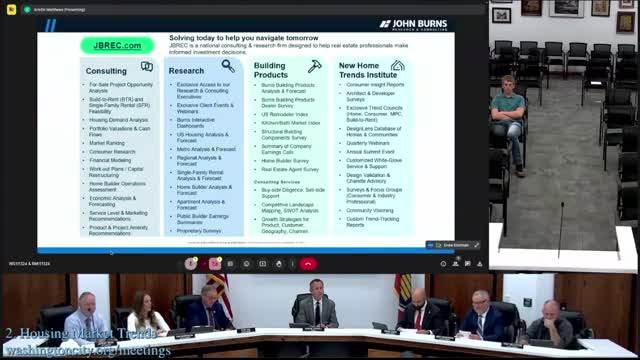Housing Market Faces Turbulence Amid Rising Interest Rates
November 14, 2024 | Washington City, Washington County, Utah
This article was created by AI summarizing key points discussed. AI makes mistakes, so for full details and context, please refer to the video of the full meeting. Please report any errors so we can fix them. Report an error »

In a recent government meeting, John Burns, a consultant based in Salt Lake City, provided an in-depth analysis of the current housing market and economic trends in Utah. With a workforce of approximately 150 employees, Burns emphasized the importance of research in making informed building decisions, particularly in the wake of significant shifts in the housing landscape due to economic pressures.
Burns noted that Salt Lake City and Utah County were among the first regions to recover from COVID-19 job losses, initially showing strong economic indicators. However, he highlighted a downturn in the housing market, attributing it to the Federal Reserve's decision to increase interest rates to combat inflation, which has risen from under 3% to over 7% in a short period. Currently, the interest rate hovers around 6.6%, with expectations of it dropping below 6% in the near future, which could stimulate the market.
The consultant presented a comparative analysis of housing markets across various metropolitan areas, indicating that Salt Lake City is currently rated as \"slow,\" alongside other previously high-growth cities like Austin and Nashville. Despite this, Burns expressed optimism for a return to normalcy, citing a projected decrease in inflation and a constrained resale supply due to a significant percentage of homeowners locked into low-rate mortgages.
Burns also discussed the implications of high home prices in Salt Lake City and Utah County, where new home prices remain elevated at approximately $558,000 and $494,000, respectively. This has led to a migration trend, with residents moving south to areas like Washington County for more affordable living options while remaining close to family and community ties.
The meeting underscored the need for continued monitoring of economic indicators, including employment rates and population growth, which Burns noted is expected to rise in Washington County. He highlighted that Utah's unique demographic profile, characterized by a younger population and higher birth rates, necessitates ongoing housing development to meet demand.
Overall, the discussions reflected a cautious yet hopeful outlook for Utah's housing market, emphasizing the importance of strategic planning and adaptation in response to evolving economic conditions.
Burns noted that Salt Lake City and Utah County were among the first regions to recover from COVID-19 job losses, initially showing strong economic indicators. However, he highlighted a downturn in the housing market, attributing it to the Federal Reserve's decision to increase interest rates to combat inflation, which has risen from under 3% to over 7% in a short period. Currently, the interest rate hovers around 6.6%, with expectations of it dropping below 6% in the near future, which could stimulate the market.
The consultant presented a comparative analysis of housing markets across various metropolitan areas, indicating that Salt Lake City is currently rated as \"slow,\" alongside other previously high-growth cities like Austin and Nashville. Despite this, Burns expressed optimism for a return to normalcy, citing a projected decrease in inflation and a constrained resale supply due to a significant percentage of homeowners locked into low-rate mortgages.
Burns also discussed the implications of high home prices in Salt Lake City and Utah County, where new home prices remain elevated at approximately $558,000 and $494,000, respectively. This has led to a migration trend, with residents moving south to areas like Washington County for more affordable living options while remaining close to family and community ties.
The meeting underscored the need for continued monitoring of economic indicators, including employment rates and population growth, which Burns noted is expected to rise in Washington County. He highlighted that Utah's unique demographic profile, characterized by a younger population and higher birth rates, necessitates ongoing housing development to meet demand.
Overall, the discussions reflected a cautious yet hopeful outlook for Utah's housing market, emphasizing the importance of strategic planning and adaptation in response to evolving economic conditions.
View full meeting
This article is based on a recent meeting—watch the full video and explore the complete transcript for deeper insights into the discussion.
View full meeting

